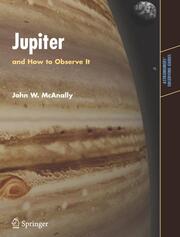Detailansicht
Jupiter and How to Observe It
Astronomers' Observing Guides
ISBN/EAN: 9781852337506
Umbreit-Nr.: 1120571
Sprache:
Englisch
Umfang: x, 218 S.
Format in cm:
Einband:
kartoniertes Buch
Erschienen am 30.11.2007
Auflage: 1/2008
- Zusatztext
- With the increasing sensitivity of the equipment available to the home astronomer, and increasing interest in celestial bodies, this Springer series is a huge helping hand to skywatchers who want to hone their skills. Astronomers' observing guides provide up-to-date information for amateur astronomers who want to know all about what it is they are observing. This is the basis of the first part of the book. The second part details observation techniques for practical astronomers, working with a range of different instruments. The book reviews the latest findings and satellite observations of Jupiter, as well as presenting superb pictures of Jupiter taken by McAnally himself, who proceeds to explain to the reader how to arrive at such beautiful results.
- Kurztext
- Jupiter is one of the most spectacular observing targets for amateur astronomers. There are various books about observing the planets, and several about Jupiter itself, but this is the only book to deal with the giant planet - its formation, structure, and incredible physics - as well as with the practical aspects of observation of the planet and its moons. The concept of the book - and of the series - is to present an up-to-date detailed physical and astrophysical description (part one); and then (part two) to consider how best to observe and image the giant planet. Jupiter and How to Observe It is a mine of information for all levels of amateur observers, from the beginning to the experienced, and will be fascinating reading for all practical amateur astronomers.
- Autorenportrait
- InhaltsangabeSection I.- The Earliest Observations.- Jupiter's Place in the Solar System.- The Physical Appearance of the Planet.- Color, Chemical Composition of the Planet, and Vertical Structure of the Atmosphere.- The Electromagnetic Environment Surrounding Jupiter.- The Jovian Satellite System.- Section II: How to Observe the Planet Jupiter.- Equipment.- Sky Conditions.- Making a Record.
